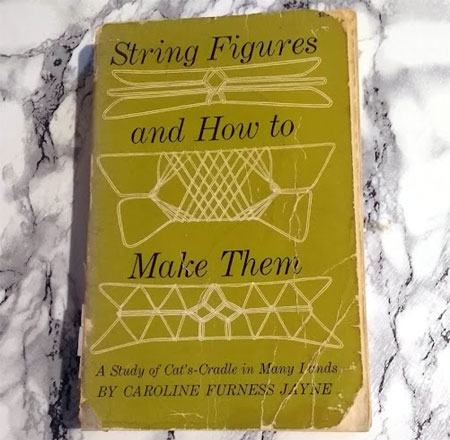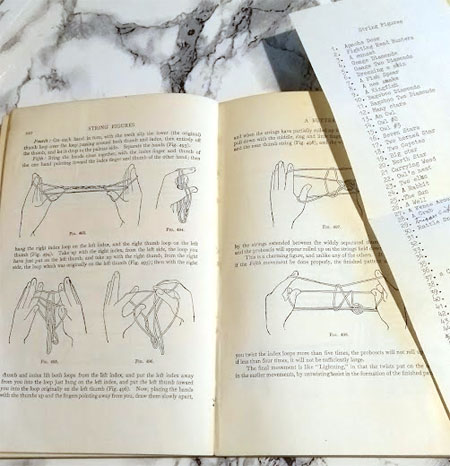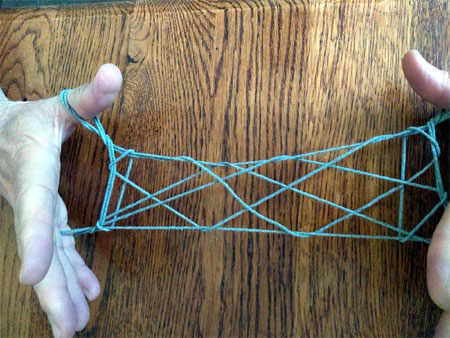The Magic String
File this one under “The Benefits of Boredom.”
At some point in the early 1960s, I somehow obtained a copy of String Figures and How to Make Them by Caroline Furness Jayne. Rarely has an acquisition made such a monumental impact on my life, and in this case, I have no idea how it happened. Was it a gift? Something my mom had that I took an interest in? Or did it just appear one day, like manna from heaven? The latter, although the least likely scenario, is what seems to be the case, as I only know that, one day, the book was there. And I was fascinated by it.
Although I don’t know how I got the book, I do know it was around 1964 (two years after it was republished, having first been released in 1906) because by the time I was in 5th grade (1965-1966), I was already entertaining my classmates with them. And, yes, they were truly, genuinely entertained—amusements were harder to come by back then.

Looking back, it’s no surprise that the book enthralled me; it offered esoteric knowledge, hours of diversion, and it didn’t cost anything. I, therefore, made time within my other pursuits—likely being the tracing of dinosaurs in the encyclopaedias, re-reading my dad’s Classic Comic books, and memorizing the Morse Code—to make a study of string.
Despite the often dense text, it didn’t take me long to get a handle on the processes and I was soon learning new figures on a daily basis. Looking at it now (yes, I still have it; it’s sitting on the bookshelf in my office) I marvel at how dedicated, or bored, I must have been to endure such passages as:
“In Ethnology, as in other sciences nothing is too insignificant to receive attention. Indeed, it is a matter of common experience among scientific men that apparently trivial objects or operations have an interest and importance that are by no means commensurate with the estimation in which they are ordinarily held…”
And
“Pass each index toward you, over the upper far thumb string, and pick up from below on the back of the index the lower far thumb string and draw it up and away from you by returning the index to its usual position (Fig. 9)”
I remind you: I was 9.

As noted earlier, the primary advantage of this pursuit was it didn’t cost anything. All you needed was string, and we had that in abundance. Surprisingly, the book suggests a string seven feet long, and then tied into a loop, which seems excessive, but once you get into it you find that’s barely adequate. The string I carry now (oh yes, I do) stretches out to nine feet.
Naturally, constant use tends to wear the string out. Then, of course, you just get a new one, but the better the string, the longer between breaks. At one point, I somehow found a very long, nylon boot lace, which enabled me to melt the ends and “weld” them together. This was very satisfactory indeed, and that particular string saw me through my 20s and well into my 30s. I have no idea when or how it met its demise, but I still miss it.
I continued to learn new figures and tricks until, in my mid-teens, I had over sixty that I could do, from memory, at the drop of a hat. And that hat dropped quite a bit. I rarely missed an opportunity to pull out what I had, by then, began referring to as The Magic String, and preform for amazed onlookers. And, again: amazed they were. I had quite a patter by that time, a little routine that I recited while making a Crab, a Sunset, a Fence around a Well, an Owl’s Nest, and, for my finale, a Worm, which was the most difficult and intricate of the figures, yet produced the least impressive results, making it—in an ironic way—doubly impressive.

I would then select a volunteer from the audience and have them assist me in some two-handed figures, such as the Turtle, Ten Times, a Six-Pointed Star, and the Saw Mill, and demonstrate some of the tricks and “catches” on them, such as the Carolina Island Catch, the Finger Catch, Will You Have a Yam, and—my Grand Finale crowd-pleaser—Hanging.
By the time I hit my 40s, I wasn’t performing as often as I used to, and some of the figures began to slip from my memory. This prompted me, once a year or so, to pull out the book—well-thumbed and ragged by then—to review the figures and refresh my memory. I wasn’t only doing this for my own amusement, however. Even then, I was already looking forward to the day when I could entertain my grandchildren and introduce them to the world of string figures. I figured I’d be the most amazing grandfather in the world, and that was something worth keeping my skills honed for.
Long story short, my 40s came and went, as did my 50s. During that time, I moved to the UK, acquired grandchildren, and waited for the day they would be old enough to appreciate string figures.
And when that day finally arrived—during a visit, when my oldest grandson was the same age I had been when I first discovered the wonders of a loop of string—I pulled out The Magic String and went through my routine while he and his younger brother watched in silence.
And they couldn’t have given less of a shit.
These days, a loop of string, no matter how skilfully handled, cannot compete with iPads, Spotify and on-demand TV.
The Magic String has, as a consequence, retired. It still resides in my pocket, and I still take it out on occasion to amuse myself, but I can only recall a handful of figures now. It seems a shame, a lifetime of string lore lost. In writing this essay, however, and thumbing through that well-worn book, an ache of nostalgia has gripped me, and I wonder if I won’t be prompted to pull out my list of learned figures and see if I can revive any of them.
Someday, my grandchildren will grow up, and have children of their own, and you never know…
For more on what I kept in my pockets, see A Dead Rat and a String to Swing It.
3 Comments
Pingback:
Patty
Love your posts. You kept me strung along…
MikeH
😉